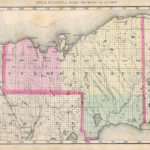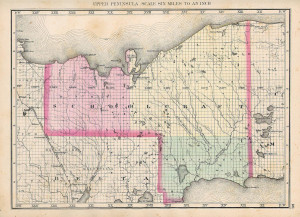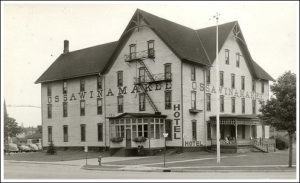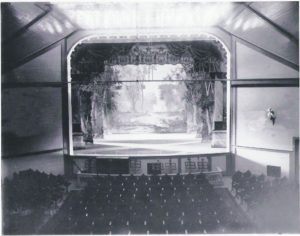Schoolcraft county was organized in 1876. It is bounded on the north by Lake Superior, on the east by Chippewa and Mackinac, on the south by Delta and Lake Michigan, on the west by Delta and Marquette. It is the fourth county in the State in size, and has an area of 2,196 square miles. Manistique, a growing town of 700 inhabitants, situated in the southern portion of the county on Lake Michigan, is the county seat. The northern and northwestern portions of the county are heavily timbered with white pine of good quality, growing on land also heavily timbered with maple, birch, and bass wood. The soil in this section is a sandy loam. The middle and western part comprises what is known as the Manistique flats—lands generally level, but with a descent to the southeast sufficient for drainage. Those lands have been largely overflowed, occasioned by beaver dams in the numerous streams or branches of the Manistique. The soil is a vegetable deposit or muck with a subsoil of marl, clay, and sand, underlaid with lime rock. Large marshes are interspersed with grass of the finest quality. The timber is principally pine on the ridges, and spruce, cedar, etc., near the rivers. The eastern and southern portions are more rolling and timbered with hardwood maple, birch, basswood, and elm on the highlands, and cedar, pine, and hemlock on the lower lands. The soil is a dark sand loam on lime rock and clay, and is a very desirable agricultural region. Homestead entries are numerous and the settlers prosperous. This portion embraces a portion of the Manistique lake region.
Tag Archives: Michigan History
The Flood Of 1920-Palm Sunday
The Flood Of 1920-Palm Sunday (March 28th, 1920) Manistique, MI-The most catastrophic event to occur in Manistique other than the fire of 1883 was the flood of 1920. Floodwaters began pouring over the flume walls in the early morning of Palm Sunday, March 28, 1920. The immediate cause of the flood was an ice jam on the Driggs River that backed the river up. When the jam broke, the water and logs in the river rushed into the Manistique River. Since the winter had an exceptional snowfall along with warmer than normal temperatures and several days of rain, the rivers draining into the Manistique River were already swollen. With the torrent of water, a west bank wall broke, causing water to rush over the flume walls and into the west side of Manistique all the way down Deer Street and Chippewa Avenue.
Currans Buy Ossa Hotel – Escanaba Daily Press March 21, 1959
Manistique – The Ossawinamakee Hotel in Manistique, regarded at the plushest in the area following its construction in 1883 has been sold by Carl Graves to Curran Chevrolet Sales here.
The hotel purchase was concluded Friday night by Graves and the three members of the Curran Partnership, Ellsworth, Leon and Donald Curran. Plans for use of the building are indefinite. Graves had owned the 42 -room wood structure the past nine years. It houses a bar, restaurant and a Western Union office in addition to the hotel facilities.
Gero Theatre, Opened 1916 For Silent Movies
Many other theaters came and went in the Manistique Community, such as the Princess Theatre, which was located on South Cedar Street and in business from 1907 to 1917. The Rex Theater and Photo-Play Theater also had short life spans. The Cedar Theater opened in the 1930’s and ran until the 1950’s. This picture shows the inside of the Gero Theater when it still was an opera house.
In 1916, Benjamin Gero Jr. and his brother Paul converted it into the Gero Theater for screening silent movies, and in 1929, talking pictures were introduced and shown. Interesting enough Mrs. Osterhout would play the piano during the silent movies. In 1941, the theater became the Oak Theater under the ownership of J.L. Le Duc.




